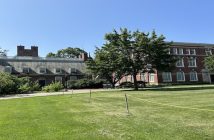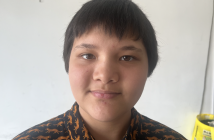As an alumnus who graduated from Dulwich College Beijing (DCB) in its second round of graduates, Shuilam Wong attended university in London and worked there for several years before returning to Beijing. She is now a graphic designer with her own collective art brand Hole in the Wall which she works in her spare time with her business partner, Jinna Kaneko.
The first time I met Wong was in an art fair at Hotel Jen, where she had a stall selling postcards and small magazines (which I later on discovered to be called ‘zines’) documenting different scenes around Beijing. She had a way of bringing places around the bustling city of Beijing to life. In front of her stall there was a sign saying: “A drawing of you for 50 kuai” (which she later did for me). I soon learned that she actually once attended DCB – the school I am at now. As I got to know more about Wong, I was fascinated by her story of an alumnus from an international background moving on to become a creative illustrator starting her own artist’s collective.
Through talking about her personal experience, Wong hopes to help and inspire other young students who wish to follow this path of becoming an artist – as she once did…
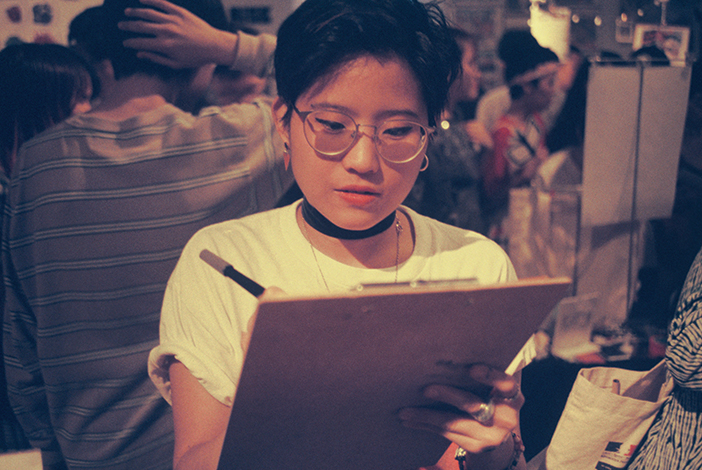
Chloe H: When did you graduate from Dulwich?
Shuilam Wong: 2011. When I first started at Dulwich, there were only classes up to year ten and I joined Dulwich at year nine, this meant that I was in the second oldest year.
Why did you choose to go to Dulwich?
I think we looked at other schools that were much bigger compared to Dulwich at the time – though it’s hard to believe, Dulwich was very small when we first started. I think my sister got into WAB and I didn’t, but our parents wanted us to be together and Dulwich was willing to take both of us.
Was there a teacher that really inspired you during your years in Dulwich?
I think there were a few teachers who really stood out. For instance, my art teacher Miss Nicola Cases was incredible. She actually introduced this whole new world to us – Amy Winehouse and The Arctic Monkeys. She was a cool teacher, she was creative and encouraged you to do whatever you wanted.
In a small community like Dulwich, did you find other people with similar passion as you?
My art class only had 6 people – it was very small. It was actually really nice because we did all our art together – Miss Cases was the only art teacher. In the class there was also Jinna – we later on founded Hole in the Wall together. She was a bit of a rebel then!
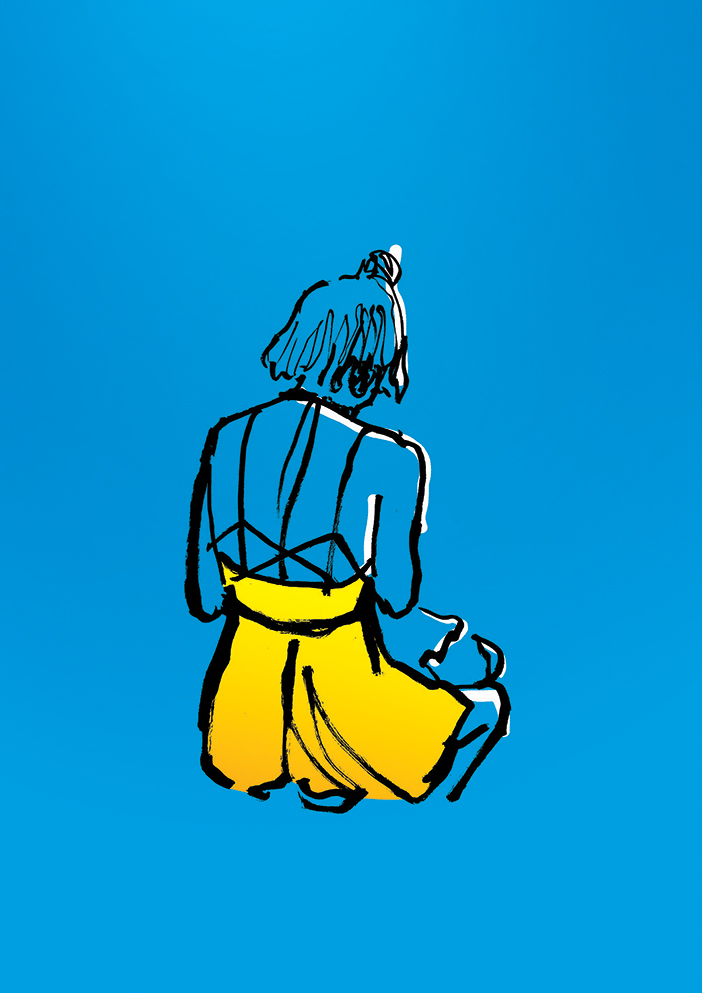 Did you always aspire to be an artist?
Did you always aspire to be an artist?
Nah – I definitely didn’t imagine this. For my IB highers I did psychology, visual arts, English…and for standard I did biology, Chinese, and math. I honestly thought I was going for psychology. I was actually top of my class – I had, like, 6s’ and 7s’ for IB.
Why did you end up choosing art over psychology?
When I was applying for university, I applied for a course in Reading in the UK for psychology – it was a dual degree, and dual degrees were very uncommon in the UK – I remember that almost none of the colleges in the UK had it. I chose to do it because I didn’t want to let go of psychology because I wanted to keep the whole ‘critical thinking’ and academic side, but I also wanted to continue doing art. I got into Reading – I believed I could handle my dual degree, but then at the last minute I spoke to my mom. My mom asked me: “Do you actually want to do this, or do you want to keep only one thing?” I thought about it and decided that I only wanted to focus on one. I really wanted to explore art – it was a completely different realm that I couldn’t imagine at the time. As soon as I made my decision to drop psychology, I just… forgot about it.
Why did you choose to come back to Beijing?
I was in-between jobs at the time. I had a job in London after I graduated as a graphic designer and when that ended, I was sort of still trying to look for a job – but also kind of failing at the same time because it was very difficult to find a job in London. I came back to Beijing to visit my dad and coincidentally found a job here and decided to stay. My new job was also as a graphic designer, but it was for a small startup.
What were the cultural differences you experienced between Beijing and London?
London is a lot more closed off, I think – if you wanted to do something creative in London, it would be very hard. You need a lot of experience, you need a lot of connections – in order to just start your career. A lot of my friends ended up doing underpaid jobs or worked at cafes and restaurants while trying to do their creative things. For me, I think London was very competitive – while Beijing definitely has more opportunities and less competition…people in Beijing are always hungry for talent.
 How did Hole in the Wall start?
How did Hole in the Wall start?
I actually met the other founder of Hole in the Wall – Jinna – in Beijing. She went to the states for university and we came back to Beijing around the same time as each other. Within a week after we met up, I was invited to exhibit some of my work. I mentioned to the curator that I wanted to make a zine (which, to elaborate, is a homemade magazine usually specializing in an area, so it’s quite miniature) and she suggested that I bring it – even though I hadn’t made it yet!
I said to Jinna: “We need to make a zine within the week of the exhibition!”, and so both of us started working.
What was the first project of Hole in the Wall?
We started making a collection of zines. We printed the first issue at a print shop and we thought that in order to save money – we would hand stitch the zine ourselves. We did like, fifty, and we were just handing them out – we didn’t sell them because they were just for fun. Funnily enough, we caught someone’s attention and they suggested that we go to the art market and a few more events.
I think in Beijing, this happened because everyone is much more closely knitted to each other – if I was in London, this would never have happened. Someone once mentioned [to me]that the degree of separation here in Beijing was around 3 people – if I just asked for the contacts of someone in my WeChat, I would probably get their contact very quickly.
How did you come up with the name Hole in the Wall?
Jinna and I were just thinking of a name for the zine, not a name for us. I think we threw in some names before Jinna asked: “How about ‘Hole in the Wall?’”.
Hole in the Wall literally means an establishment – it could be a bar, it could be a restaurant, it could be a café…so it’s very shabby, not very clean…but it works. I think that’s us – we’re not polished, we’re not planned out – but that doesn’t mean things don’t work out for us.
 What challenges did you have to face in starting Hole in the Wall?
What challenges did you have to face in starting Hole in the Wall?
Honestly, starting Hole in the Wall wasn’t a challenge. I didn’t even think of expanding it beyond what it was from that small zine. It was easy because there was a lot of support, there were a lot of people who were very enthusiastic about it. Maintaining it was the hard part – maintaining the standards, maintaining the vision…it was very hard. Even now I still face challenges keeping it going.
How do you balance your full-time job with the responsibilities of creating a zine?
I have a full-time job during the weekdays as a graphic designer, and on weekends I’m doing workshops and events for Hole in the Wall. It’s spread out pretty evenly, really.
Do you have a role model whom you look up to in terms of art?
There are a few people I follow on Instagram whom I look up to – one of them is Nelson Ng. His magazine LOST is based in Shanghai and he’s been doing very well. He’s an inspiration because he started his magazine himself three or four years ago. People submit articles of their own travel stories to the magazine.
Nelson’s first magazine consisted of his own friends’ travel stories. Because he came from Singapore, he tried to sell the magazine there in Singapore but he failed to do that because it was not a conventional magazine – it was very thick and only had personal stories. The reason that he succeeded was by leaving his magazines in cafes in Shanghai – people started to take pictures of them to post on social media with their coffee.
How would you define your own drawing style?
I would say its quick, thick, rough, rushed – it’s unrefined, you know? It’s organic, I guess. What I actually do is something called ‘reportage illustration’. It’s a form of illustration where you actually draw what you see. The most common form of reportage illustration is in courtrooms. Illustrators are also brought to war zones and they try to sketch what is going on – sketching is relatively more useful than using a camera, as using cameras to record war zones can be intimidating. I would definitely want to do something similar to that someday.
What do you enjoy drawing the most?
Definitely people – I like drawing people in interesting positions: when they are talking to each other (any sort of interaction is interesting) and I like to record them.
Has your drawing style changed along the years?
My drawing style definitely is a lot less realistic. In Dulwich, I did a lot of acrylic painting and very slow, calculated paintings – paintings which would take 6-10 hours of sitting to finish at a time. I really enjoyed those, but it’s just not “me” anymore. I used to be able to sit around for a long time, but now I just can’t sit still while I’m sketching – I would get very bored! I like capturing energy in a person – something special about them which can show through, like their personality – in the short five minutes I interact with them.
I think this is because ever since I went to university, I was taught to focus more on “capturing the idea” very quickly – and you can’t really do that with a painting of immense detail.
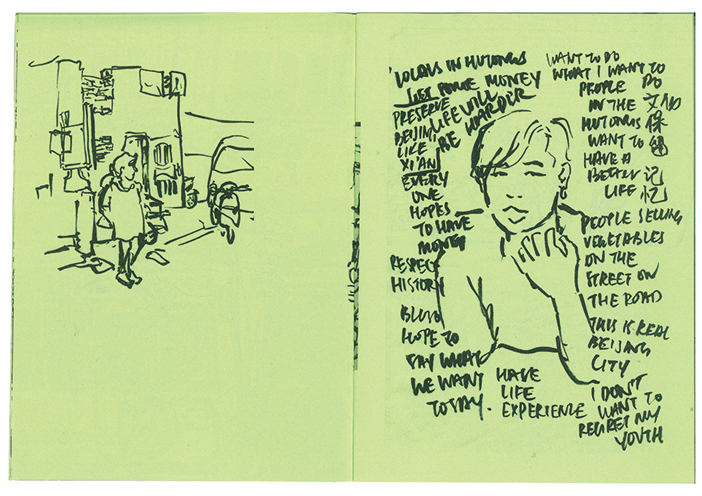 What do you look for in a good piece of artwork?
What do you look for in a good piece of artwork?
I definitely look for the message behind it, or the impact it gives. I think that an artwork doesn’t have to be limited to a gallery – it could happen anywhere.
Do you think you would have gotten where you are today without your parents’ help?
No – I don’t think I would be here today without my parents’ help. I think that without the form of education I had, I wouldn’t get to where I am – nor would I be the person I am today. I think some people don’t like to admit it, but where you are now really depends on your parents and your education. I’m glad that I had a good education, and that I had loving parents who are supportive of what I want to do and who I am.
Art is quite a popular curriculum to pursue in international schools here in Beijing – what advice would you give to young people who are considering art as their future career?
If art is something you’re passionate about, you have to be prepared to be open-minded. You have to experiment and you have to explore with different ideas and themes – you can’t be stuck with just one medium.
When I was in Dulwich, I was stuck on acrylics and oil, but once I went to university I realized that you can do so much more: you can try videos, animation, try performing arts…don’t just stick to 2D – try 3D and multimedia stuff. Nowadays, you can even do AR and VR. Make full use of the resources you have right now.
Where would we be able to find Hole in the Wall in Beijing?
I pop up every now and then in different art markets and art-book fairs – I’m also involved in lots of workshops and stuff. I can mostly be found around in the Hutong areas near Gulou and sometimes my zines are sold in shops.
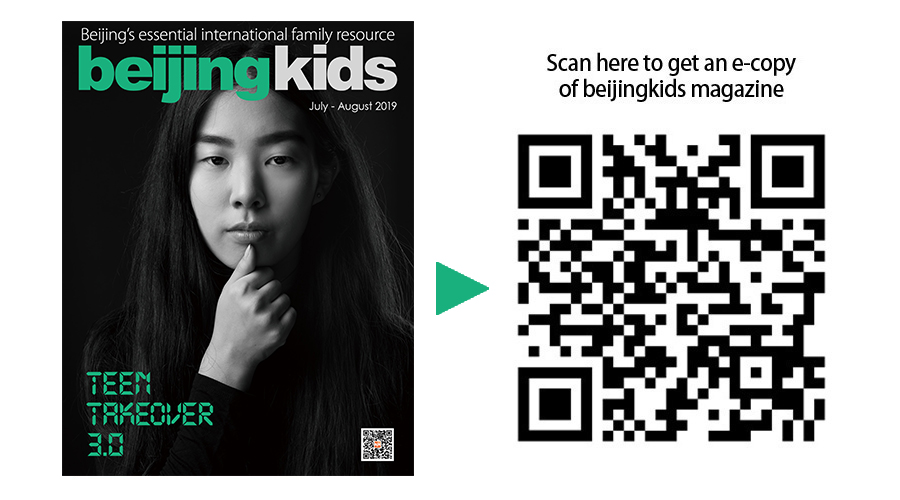
This article appeared in the beijingkids July-August 2019 Teen Takeover issue


